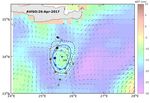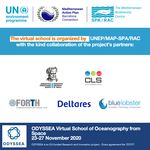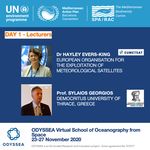VIRTUAL SCHOOL OF OCEANOGRAPHY FROM SPACE - SUMMARY OF THE EVENT - ODYSSEA is an EU-funded Research and Innovation project - Grant agreement No 727277
←
→
Page content transcription
If your browser does not render page correctly, please read the page content below
VIRTUAL SCHOOL OF
OCEANOGRAPHY FROM SPACE
SUMMARY OF THE EVENT
ODYSSEA is an EU-funded Research and Innovation project – Grant agreement No 727277
1VIRTUAL SCHOOL OF
OCEANOGRAPHY FROM SPACE
SUMMARY OF THE EVENT
The Virtual School on oceanography from Space was carried out successfully from 23 to 27 November,
with a sustained attendance of over 80 participants from 26 countries of five continents.
The training webinar was organized by UNEP/MAP-SPA/RAC within the framework of the ODYSSEA
project, funded by the European Union, with the support of ODYSSEA partners and the kind collaboration
of specialized lecturers from renown organizations in the field of satellite data processing, such as
EUMETSAT, LEGOS and ORBITAL-EOS.
Opening the first session, Mr Khalil ATTIA, SPA/RAC Director, underlined that the main goal of the
ODYSSEA School is to give technical skills to the participants in handling satellite and in-situ data in
synergy, and to develop marine research approach based on multi-sources information, allowing them
to become ready to face the challenges of the next decade 2021-2030, being declared by UN as the
decade of Oceans.
Professor Georgios SYLAIOS, from the Democritus University of Thrace (Greece), and coordinator of the
ODYSSEA project, pursued with the first training session to introduce the webinar. He stressed the
importance of satellite data and the Copernicus program for the ODYSSEA project. He explained how
the ODYSSEA platform (marinomica.com) is designed to facilitate the access and processing of
oceanographic data to a large public and end-users, who need to explore such data for their daily
activities.
The second lecturer, Dr Hayley Evers-King, marine specialist at the European Organization for the
Exploitation of Meteorological Satellites (EUMETSAT), gave an overview on the satellite functionalities
for Ocean monitoring at different spatial and temporal scales.
Why would we want to observe the oceans from space?
Dr Evers-King presented the panoply of Earth Observing Satellite of the European Spatial Agency
currently in orbit (SENTINEL), how to access to the data through different platform and why we would
2want to observe the oceans from space in different domains. During the course, Dr Hayley Evers-King
focused especially on measuring sea surface temperature and ocean colour from space, using
respectively Thermal Infrared Radiometer and Visible imaging multi-spectral radiometers.
Other types of sensors are also available to investigate other physical parameters characterizing the
ocean. For instance, Dr Florence Birol (French Laboratory of Geophysical Studies and Spatial
Oceanography, LEGOS) explained extensively the use of Radar Altimeter data to track the variability of
Sea Surface Height (SSH), both in the open ocean and in the nearshore area. A special focus was given
to the new developments in the use of altimetric data in the coastal zone and dedicated tools for
processing and analysis (X-track). LEGOS team (Florence, Fernando Niño and Fabien Leger) provided
tutorial material for the webinar attendees and a session was dedicated to the processing of altimetric
data using python scripts.
Based on altimetric data processing, as well, Dr Cori PEGLIASCO, from CLS (Collecte Localisation
Satellite, France) showed how Meso-scale eddies dynamics are detected and tracked and explained the
correlation between Sea Level, Temperature and chlorophyll concentration within eddies, and their
importance in sea water mixing and enrichment by nutriments in different key-zone of the
Mediterranean.
As they play a dominant role in heat and energy transport, eddies must be accurately addressed by earth
observing systems, as pointed by Dr Katerina SPANOUDAKI during her lecture on hydrodynamic models
validation using satellite data assimilation.
Two other applications on the use of satellite data to monitoring the coastal environment, were
presented by Konstantinos ZACHOPOULOS and Dr Nikolas KOKKOS (Democritus University of Thrace,
Greece), respectively, on coastal erosion patterns and Suspended Particulate Matter in coastal water.
3Finally, a very important outcome of the ODYSSEA project, which is the Marinomica platform, was
presented during the training webinar by Simon Keeble, manager of the Blue lobster Inc.
Marinomica is a word built from Marine and Economic, with reference to the Blue Economy and Blue
Growth concept.
Dr LÖRINC MÉSZÁROS, Specialized in Hydro-informatic at DELTARES, presented an innovative
application implemented on Marinomica, which allows the calculation of Eutrophication indices, a
fundamental parameter for the assessment and monitoring of the Good Environmental Status of the
Mediterranean Sea.
4Following the training webinar, an evaluation was performed through a survey among the participants.
The answers received showed an excellent appreciation of the training and a relevance of the chosen
themes with regards to their expectations.
5You can also read



























































